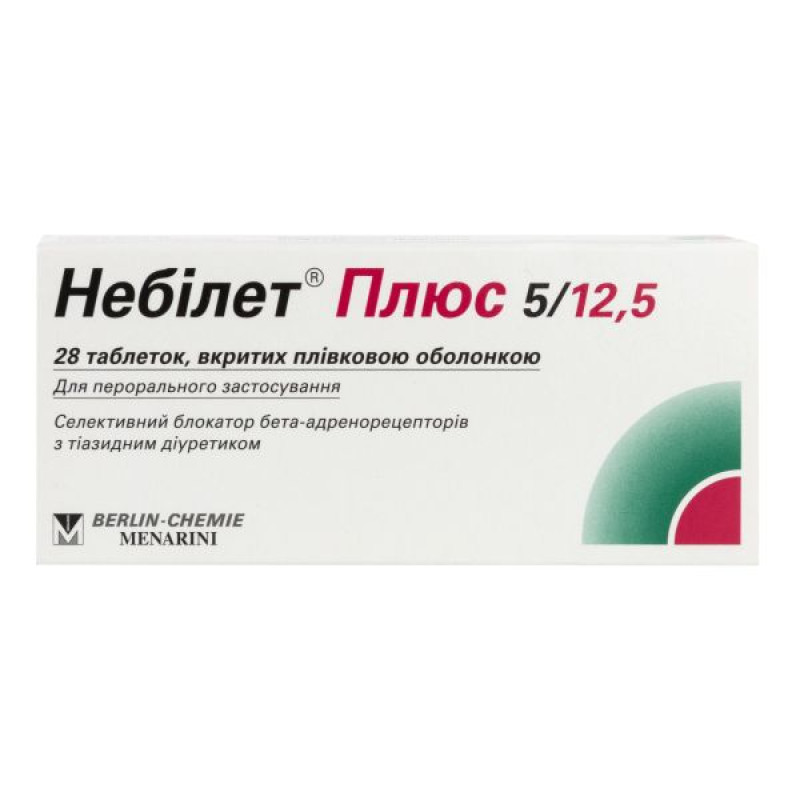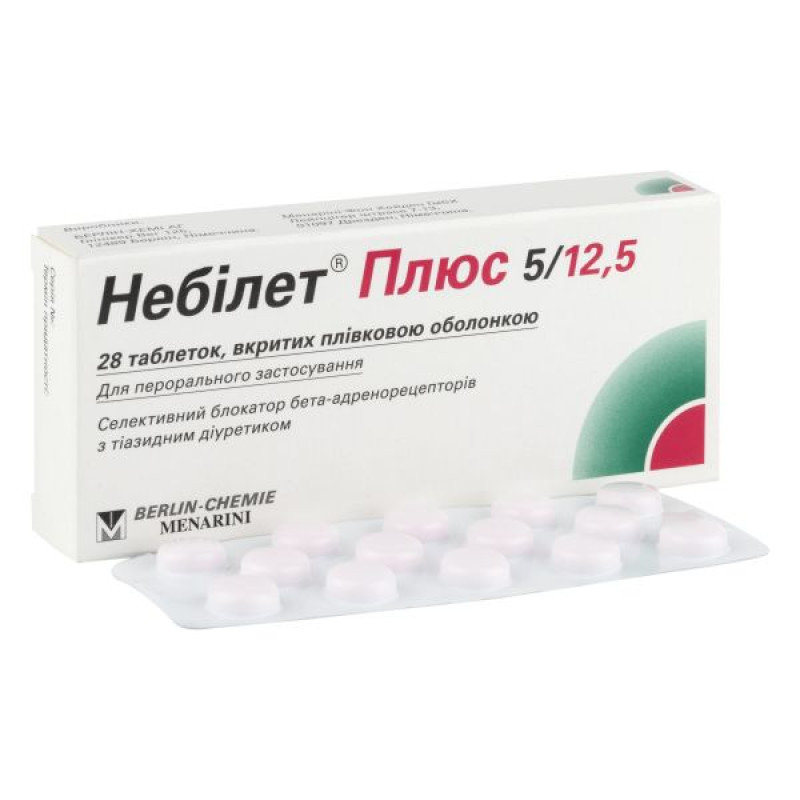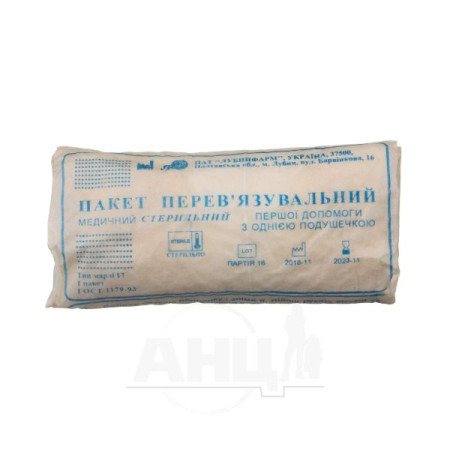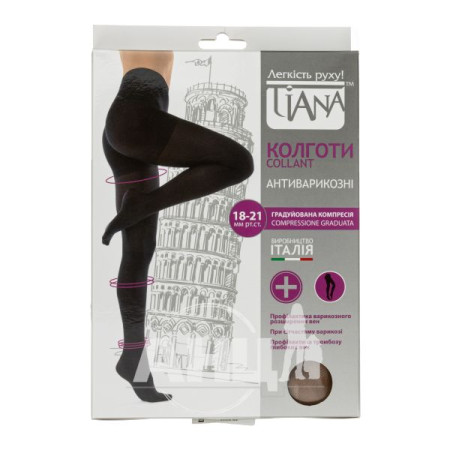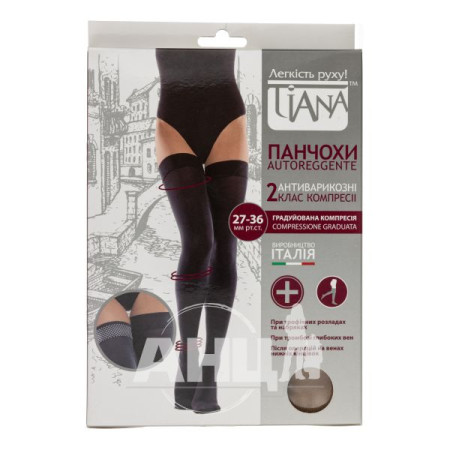Nebilet plus film-coated tablets 5 mg + 12.5 mg No. 28
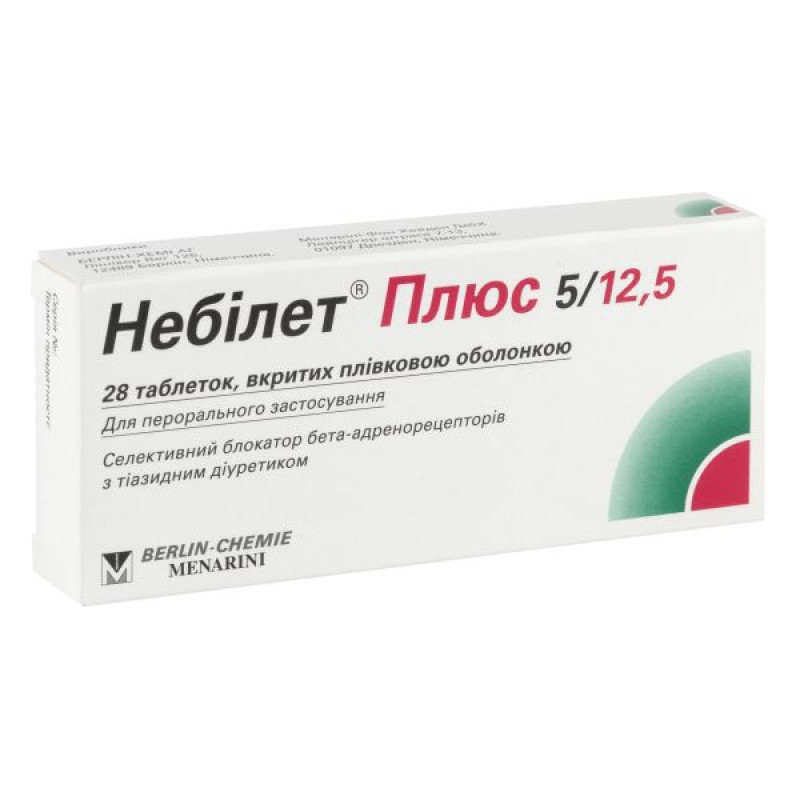
Instructions for Nebilet plus film-coated tablets 5 mg + 12.5 mg No. 28
Composition
active ingredients: nebivolol, hydrochlorothiazide;
1 film-coated tablet contains nebivolol (as nebivolol hydrochloride) 5 mg and hydrochlorothiazide 12.5 mg;
excipients: polysorbate 80, hypromellose, lactose monohydrate, corn starch, croscarmellose sodium, microcrystalline cellulose, colloidal anhydrous silicon dioxide, magnesium stearate;
shell: hypromellose, microcrystalline cellulose, macrogol stearate, titanium dioxide (E 171), carminic acid (E 120).
Dosage form
Film-coated tablets.
Main physicochemical properties: off-pink, round, slightly biconvex, film-coated tablets, embossed with "5/12.5" on one side and scored on the other. The score is intended only for breaking the tablet for easier swallowing, and not for dividing the tablet into equal doses.
Pharmacotherapeutic group
Selective blockers of beta-adrenergic receptors with thiazide diuretics.
ATX code C07B B12.
Pharmacological properties
Pharmacodynamics
Nebilet® Plus 5/12.5 is a combination of nebivolol, a selective beta-receptor antagonist, and hydrochlorothiazide, a thiazide diuretic. The combination of these ingredients has an additive antihypertensive effect and reduces blood pressure to a greater extent than the individual components.
Nebivolol is a racemate consisting of two enantiomers: SRRR-nebivolol (D-nebivolol) and RSSS-nebivolol (L-nebivolol). It combines two pharmacological properties:
Nebivolol is a competitive and selective β1-adrenoceptor blocker: the SRRR enantiomer (D-enantiomer) has this effect; it has mild vasodilating properties due to the interaction with L-arginine/nitric oxide.
With single and repeated administration of nebivolol, heart rate and blood pressure are reduced at rest and during exercise in both normotensive and hypertensive patients. The antihypertensive effect is maintained during long-term treatment.
At therapeutic doses, nebivolol lacks α-adrenergic antagonism.
During short-term and long-term treatment with nebivolol in patients with arterial hypertension, systemic vascular resistance decreases. Despite the decrease in heart rate, the decrease in cardiac output at rest and during exercise may be limited by an increase in stroke volume. The clinical significance of this hemodynamic difference compared with that with other β1-adrenergic blockers is not yet fully understood.
In patients with arterial hypertension, nebivolol increases the vascular response to acetylcholine mediated by nitric oxide; in patients with endothelial dysfunction, this response is reduced.
In vitro and in vivo animal experiments have shown that nebivolol does not possess intrinsic sympathomimetic activity.
In vitro and in vivo animal experiments have shown that at pharmacological doses nebivolol has no membrane-stabilizing activity.
In healthy volunteers, nebivolol has no significant effect on the ability to tolerate maximum physical exertion or on endurance.
Hydrochlorothiazide is a thiazide diuretic. Thiazides act on the renal tubular mechanisms of electrolyte reabsorption, directly increasing the excretion of sodium and chloride in approximately equal amounts. The diuretic action of hydrochlorothiazide reduces plasma volume, increases plasma renin activity, and increases aldosterone secretion, with subsequent increases in urinary potassium and bicarbonate losses and decreases in serum potassium. With hydrochlorothiazide, diuresis occurs within approximately 2 hours, and the peak effect is reached approximately 4 hours after administration, while the effect lasts for approximately 6–12 hours.
Non-melanoma skin cancer (NMSC). Available epidemiological data have shown an association between cumulative dose of hydrochlorothiazide and the development of NMSC. One study included 71,533 patients with basal cell carcinoma (BCC) and 8,629 patients with squamous cell carcinoma (SCC), compared with 1,430,833 and 172,462 control subjects, respectively. High-dose hydrochlorothiazide (cumulative ≥ 50,000 mg) was associated with an adjusted odds ratio (OR) of 1.29 (95% confidence interval (CI): 1.23–1.35) for BCC and 3.98 (95% CI: 3.68–4.31) for SCC. A clear relationship between cumulative dose and response was observed for both BCC and SCC. Another study showed a possible association between lip cancer (LC) and hydrochlorothiazide exposure: 633 patients with lip cancer were compared with 63,067 controls using a risk-adjusted sampling strategy. A cumulative dose-response relationship was demonstrated: the adjusted OR was 2.1 (95% CI: 1.7–2.6), increasing to an OR of 3.9 (3.0–4.9) at high doses (25,000 mg) and an OR of 7.7 (5.7–10.5) at the highest cumulative dose (100,000 mg) (see also section 4.4).
Pharmacokinetics
Concomitant use of nebivolol and hydrochlorothiazide does not affect the bioavailability of either active substance. The combination tablet is bioequivalent to the concomitant use of the individual components.
Nebivolol
After oral administration, both enantiomers of nebivolol are rapidly absorbed. The absorption of nebivolol is not affected by food; nebivolol can be taken regardless of meals.
The bioavailability of orally administered nebivolol is on average 12% in extensive metabolisers and almost complete in poor metabolisers. At steady state and at the same dose level, the peak plasma concentration of unchanged nebivolol is approximately 23 times higher in poor metabolisers than in extensive metabolisers. When the unchanged drug and active metabolites are taken into account, the difference in peak plasma concentrations is 1.3-1.4 times. Due to the difference in metabolic rates, the dosage of nebivolol should always be adjusted to the individual needs of the patient: in this case, poor metabolisers may require lower doses.
Plasma concentrations are dose-proportional over the range of 1 to 30 mg. The pharmacokinetics of nebivolol are not affected by age.
Distribution
In plasma, both enantiomers of nebivolol bind predominantly to albumin. Plasma protein binding is 98.1% for SRRR-nebivolol and 97.9% for RSSS-nebivolol.
Biotransformation
Nebivolol is extensively metabolized, partly to active hydroxy metabolites. Nebivolol is metabolized by alicyclic and aromatic hydroxylation, N-dealkylation and glucuronidation; in addition, glucuronides of hydroxy metabolites are formed. The metabolism of nebivolol by aromatic hydroxylation depends on the genetic oxidative polymorphism of CYP2D6.
Breeding
In patients with extensive metabolism, the half-life of the enantiomers of nebivolol is approximately 10 hours. In patients with poor metabolism, it is 3-5 times longer. In patients with extensive metabolism, plasma levels of the RSSS enantiomer are slightly higher than for the SRRR enantiomer. In patients with poor metabolism, this difference increases. In patients with extensive metabolism, the half-life of the hydroxy metabolites of both enantiomers is on average 24 hours, while in patients with poor metabolism, it is prolonged by almost half.
Steady-state plasma levels in most patients (rapid metabolizers) are reached within 24 hours for nebivolol and after a few days for the hydroxymetabolites.
One week after administration, 38% of the dose is excreted in the urine and 48% in the feces. Urinary excretion of unchanged nebivolol is less than 0.5% of the dose.
Hydrochlorothiazide
Absorption
Hydrochlorothiazide is well absorbed (65 to 75%) after oral administration. Plasma concentrations are linearly related to the dose administered. The absorption of hydrochlorothiazide is dependent on intestinal transit time: it increases when intestinal transit time is slow, e.g. when administered with food. When plasma levels were monitored for at least 24 hours, the plasma elimination half-life ranged from 5.6 to 14.8 hours, with peak plasma concentrations occurring within 1 to 5 hours after dosing.
Distribution
Hydrochlorothiazide is 68% bound to plasma proteins, and its apparent volume of distribution is 0.83–1.14 L/kg. Hydrochlorothiazide crosses the placenta but not the blood-brain barrier.
Biotransformation
The metabolism of hydrochlorothiazide is very low. Almost all hydrochlorothiazide is excreted unchanged in the urine.
Breeding
Hydrochlorothiazide is excreted primarily by the kidneys. More than 95% of hydrochlorothiazide is recovered in the urine as unchanged drug 3–6 hours after oral administration. In patients with renal disease, plasma concentrations of hydrochlorothiazide are increased and the elimination half-life is prolonged.
Preclinical safety data
Preclinical safety data of the combination of nebivolol and hydrochlorothiazide revealed no special hazard for humans based on conventional studies of safety pharmacology, repeated dose toxicity, genotoxicity and carcinogenic potential of the individual components.
Indication
Treatment of essential hypertension.
The fixed combination drug Nebilet® Plus 5/12.5 is indicated for patients whose blood pressure is adequately controlled with the combined use of 5 mg nebivolol and 12.5 mg hydrochlorothiazide.
Contraindication
Hypersensitivity to the active substances or any of the auxiliary substances listed in the "Composition" section; increased sensitivity to other substances - sulfonamide derivatives (since hydrochlorothiazide is a sulfonamide derivative); liver failure or impaired liver function; anuria, severe renal failure (creatinine clearance less than 30 ml/min); acute heart failure, cardiogenic shock or episodes of decompensated heart failure requiring the administration of drugs with a positive inotropic effect; sinus node weakness syndrome, including sinoatrial blockade; second- and third-degree atrioventricular block (without an implanted pacemaker); bradycardia (before the start of treatment, the heart rate is reduced to less than 60 beats/min); arterial hypotension (systolic blood pressure less than 90 mm Hg); severe disorders of peripheral circulation; bronchospasm and bronchial asthma in history; untreated pheochromocytoma; metabolic acidosis; resistant hypokalemia, hypercalcemia, hyponatremia and symptomatic hyperuricemia.
Interaction with other medicinal products and other types of interactions
Pharmacodynamic interactions
Nebivolol
The interactions listed below apply to beta-adrenergic receptor antagonists in general.
Combinations that are not recommended
Class I antiarrhythmic drugs (quinidine, hydroquinidine, cibenzoline, flecainide, disopyramide, lidocaine, mexiletine, propafenone). The effect on atrioventricular conduction time and the negative inotropic effect may be increased (see section "Special instructions").
Calcium channel blockers such as verapamil/diltiazem: Negative effects on contractility and atrioventricular conduction. Intravenous administration of verapamil to patients treated with beta-blockers may result in severe hypotension and atrioventricular block (see section 4.4).
Centrally acting antihypertensives (clonidine, guanfacine, moxonidine, methyldopa, rilmenidine). Concomitant use of centrally acting antihypertensives may worsen heart failure due to decreased central sympathetic tone (decreased heart rate and cardiac output, vasodilation) (see section 4.4). Abrupt withdrawal, especially before discontinuation of beta-blockers, may increase the risk of rebound hypertension.
Combinations to be used with caution
Class III antiarrhythmic drugs (amiodarone). The effect on atrioventricular conduction time may be potentiated.
Anesthetics - volatile halogens. The simultaneous use of beta-adrenergic receptor blockers and anesthetics may attenuate reflex tachycardia and increase the risk of arterial hypotension (see section "Special instructions"). As a general rule, abrupt withdrawal of beta-blocker treatment should be avoided. The anesthesiologist should be informed if the patient is receiving Nebilet® Plus 5/12.5.
Insulin and oral antidiabetic agents: Although nebivolol does not affect glucose levels, concomitant use may mask certain symptoms of hypoglycemia (palpitations, tachycardia).
Baclofen (antispastic agent), amifostine (adjunctive agent in the treatment of anticancer drugs). Concomitant use with antihypertensive agents may significantly reduce blood pressure, so the dose of the antihypertensive agent should be adjusted accordingly.
Combinations to consider
Digitalis glycosides. Concomitant use may increase atrioventricular conduction time. Clinical trials with nebivolol have not demonstrated any clinical interaction. Nebivolol does not affect the kinetics of digoxin.
Dihydropyridine calcium antagonists (amlodipine, felodipine, lacidipine, nifedipine, nicardipine, nimodipine, nitrendipine). Concomitant use may increase the risk of arterial hypotension; an increased risk of further deterioration of ventricular pumping function in patients with heart failure cannot be excluded.
Antipsychotics, antidepressants (tricyclics, barbiturates and phenothiazines). Concomitant use may increase the hypotensive effect of beta-blockers (additive effect).
Nonsteroidal anti-inflammatory drugs (NSAIDs). Do not affect the blood pressure lowering effect of nebivolol.
Sympathomimetics: Concomitant use may antagonize the effect of beta-adrenergic blocking agents. Beta-adrenergic agents may lead to unopposed alpha-adrenergic activity of sympathomimetics with both alpha and beta-adrenergic effects (risk of hypertension, severe bradycardia and heart block).
Hydrochlorothiazide
Potential interactions related to hydrochlorothiazide.
Concurrent use is not recommended.
Medicinal products affecting potassium levels: The potassium-lowering effect of hydrochlorothiazide may be potentiated by concomitant use of other medicinal products associated with potassium loss and hypokalaemia (e.g. other kaliuretic diuretics, laxatives, corticosteroids, ACTH, amphotericin, carbenoxolone, penicillin G sodium or salicylic acid derivatives). Therefore, such concomitant use is not recommended.
Concomitant use requiring caution.
Non-steroidal anti-inflammatory drugs (NSAIDs): NSAIDs (e.g. acetylsalicylic acid (> 3 g/day), COX-2 inhibitors and non-selective NSAIDs) may reduce the antihypertensive effect of thiazide diuretics.
Calcium salts: Thiazide diuretics may increase serum calcium levels due to decreased excretion. If calcium supplements are prescribed, serum calcium levels should be monitored and adjusted accordingly.
Digitalis glycosides: Thiazide-induced hypokalemia or hypomagnesemia may precipitate digitalis-induced cardiac arrhythmias.
Medicinal products affected by changes in serum potassium: Periodic monitoring of serum potassium and ECG is recommended when Nebilet Plus 5/12.5 is used with medicinal products affected by changes in serum potassium (e.g. digitalis glycosides and antiarrhythmics) and with the following medicinal products known to induce torsades de pointes (including some antiarrhythmics), as hypokalaemia is a predisposing factor for torsades de pointes (ventricular tachycardia):
Class Ia antiarrhythmics (e.g. quinidine, hydroquinidine, disopyramide); Class III antiarrhythmics (e.g. amiodarone, sotalol, dofetilide, ibutilide); Some antipsychotics (e.g. thioridazine, chlorpromazine, levomepromazine, trifluoperazine, cyamemazine, sulpiride, sultopride, amisulpride, tiapride, pimozide, haloperidol, droperidol); Others (e.g. bepridil, cisapride, diphemanil, erythromycin intravenously, halofantrine, mizolastine, pentamidine, sparfloxacin, terfenadine, vincamine intravenously).
Non-depolarizing skeletal muscle relaxants (e.g. tubocurarine). Hydrochlorothiazide may potentiate the effect of non-depolarizing skeletal muscle relaxants.
Antidiabetic medicinal products (oral agents and insulin): Thiazide therapy may affect glucose tolerance. Dosage adjustment of the antidiabetic medicinal product may be required (see section 4.4).
Metformin: Metformin should be used with caution due to the risk of lactic acidosis caused by possible renal impairment associated with the use of hydrochlorothiazide.
Beta-blockers and diazoxide: Thiazides may enhance the hyperglycaemic effect of beta-blockers other than nebivolol and diazoxide.
Pressor amines (e.g. noradrenaline). The effect of pressor amines may be reduced.
Medicines used to treat gout (probenecid, sulfinpyrazone, allopurinol). Dosage adjustment of uric acid-lowering medicines may be necessary, as hydrochlorothiazide may increase serum uric acid levels. The dose of probenecid or sulfinpyrazone may need to be increased. Concomitant use of thiazides may increase the incidence of hypersensitivity reactions to allopurinol.
Amantadine: Thiazides may increase the risk of side effects caused by amantadine.
Salicylates: When high doses of salicylates are used, hydrochlorothiazide may potentiate their toxic effects on the central nervous system.
Cyclosporine: Concomitant treatment with cyclosporine may increase the risk of hyperuricemia and gout-like complications.
Iodinated contrast media: In case of diuretic-induced dehydration, there is an increased risk of acute renal failure, especially with high doses of iodine preparations. The patient should be rehydrated before use.
Potential interactions due to both nebivolol and hydrochlorothiazide
Concomitant use that must be taken into account.
Other antihypertensive drugs: When used concomitantly with other antihypertensive drugs, additive hypotensive effects or potentiation of their action may occur.
Antipsychotics, tricyclic antidepressants, barbiturates, narcotics and alcohol. The combined use of Nebilet® Plus 5/12.5 with these drugs may enhance the hypotensive effect and/or lead to postural hypotension.
Pharmacokinetic interactions
Nebivolol
Since the CYP2D6 isoenzyme is involved in the metabolism of nebivolol, concomitant use with substances that inhibit this enzyme, in particular paroxetine, fluoxetine, thioridazine and quinidine, may lead to increased plasma levels of nebivolol with an increased risk of excessive bradycardia and side effects.
Combining nebivolol with nicardipine slightly increases the plasma levels of both drugs without changing the clinical effect. Concomitant use of alcohol, furosemide or hydrochlorothiazide does not affect the pharmacokinetics of nebivolol. Nebivolol does not affect the pharmacokinetics and pharmacodynamics of warfarin.
Hydrochlorothiazide
The absorption of hydrochlorothiazide is impaired in the presence of anion exchange resins (e.g. cholestyramine and colestipol resins).
Cytotoxic agents: When hydrochlorothiazide is used concomitantly with cytotoxic agents (e.g. cyclophosphamide, fluorouracil, methotrexate), an increase in bone marrow toxicity (including granulocytopenia) should be expected.
Application features
All precautions for each component separately, as stated below, should also apply to the fixed combination product Nebilet® Plus 5/12.5. See also section “Adverse reactions”.
Nebivolol
The following warnings and precautions apply to beta-adrenergic blockers in general.
Anesthesia: Continued beta-blockade reduces the risk of arrhythmias during induction of anesthesia and intubation. If beta-blockade is discontinued in preparation for surgery, the beta-blocker should be discontinued at least 24 hours beforehand.
Caution should be exercised with some anesthetics that cause myocardial depression.
The patient can be protected from vagal reactions by intravenous administration of atropine.
Cardiovascular disorders: In general, beta-blockers should not be used in patients with untreated congestive heart failure (CHF) unless their condition has been stabilized.
In patients with coronary heart disease, beta-blocker therapy should be discontinued gradually, i.e. over 1–2 weeks. If necessary, replacement therapy should be initiated at the same time to prevent exacerbation of angina.
Beta-adrenergic receptor antagonists can cause bradycardia: if the pulse rate falls below 50–55 beats/min at rest and/or the patient has symptoms suggestive of bradycardia, the dosage should be reduced.
Beta-adrenergic receptor antagonists should be used with caution:
patients with peripheral circulatory disorders (Raynaud's disease or intermittent claudication syndrome), as these disorders may be exacerbated; patients with first-degree atrioventricular block due to the negative effect of beta-blockers on conduction time; patients with Prinzmetal's angina due to coronary artery spasm caused by alpha-receptor activation on the background of beta-receptor blockade: beta-adrenergic blockers may increase the number and duration of angina attacks.
The combination of nebivolol with calcium channel blockers such as verapamil and diltiazem, with class I antiarrhythmic drugs and with centrally acting antihypertensive drugs is generally not recommended, for detailed information see section "Interaction with other medicinal products and other types of interactions".
Metabolic/endocrine disorders: Nebivolol does not affect glucose levels in diabetics. However, caution is required in patients with diabetes mellitus, as nebivolol may mask certain symptoms of hypoglycemia (tachycardia, palpitations).
Beta-blockers may mask the tachycardia symptoms of hyperthyroidism. Abrupt withdrawal may exacerbate symptoms.
Respiratory disorders: Beta-adrenergic receptor antagonists should be used with caution in patients with chronic obstructive pulmonary disease, as airway obstruction may be exacerbated.
Others: Beta-adrenergic receptor antagonists should be used in patients with a history of psoriasis only after careful consideration.
Beta-adrenergic receptor antagonists may increase sensitivity to allergens and the severity of anaphylactic reactions.
Hydrochlorothiazide
Renal impairment. Maximum benefit from thiazide diuretics can only be expected in the absence of impaired renal function. In patients with renal disease, thiazides may exacerbate azotemia. In patients with impaired renal function, cumulative effects of this active substance may develop. If there is obvious progression of renal dysfunction, as evidenced by an increase in non-protein nitrogen, careful reassessment of therapy with regard to the question of diuretic withdrawal is necessary.
Metabolic and endocrine effects: Thiazide therapy may impair glucose tolerance. Adjustment of insulin or oral hypoglycemic agents may be required (see Interactions). Latent diabetes mellitus may become manifest during thiazide therapy.
Thiazide diuretic therapy has been associated with increases in cholesterol and triglyceride levels. Thiazide therapy may precipitate hyperuricemia and/or gout in some patients.
Thiazides, including hydrochlorothiazide, may cause fluid or electrolyte imbalance (hypokalemia, hyponatremia, and hypochloraemic alkalosis). Warning signs of fluid or electrolyte imbalance include dry mouth, thirst, weakness, lethargy, drowsiness, agitation, muscle pain or cramps, muscular fatigue, hypotension, oliguria, tachycardia, and gastrointestinal disturbances such as nausea or vomiting.
The risk of hypokalemia is highest in patients with cirrhosis of the liver, in patients with rapid diuresis, in patients with insufficient oral electrolyte intake and in patients receiving concomitant therapy with corticosteroids or ACTH (see section "Interaction with other medicinal products and other forms of interaction"). The risk of hypokalemia is particularly high in patients with QT prolongation syndrome, congenital or iatrogenic. Hypokalemia increases the cardiotoxicity of digitalis glycosides and the risk of cardiac arrhythmias. In patients at risk of hypokalemia, more frequent monitoring of plasma potassium is indicated, starting from the first week of therapy.
In hot weather, dilutional hyponatremia may occur in patients prone to edema. Chloride deficiency is usually mild and usually does not require treatment.
Thiazides may reduce urinary calcium excretion and may cause intermittent and minor increases in serum calcium in the absence of established disorders of calcium metabolism. Significant hypercalcemia may be a manifestation of latent hyperparathyroidism. Thiazides should be discontinued before testing for parathyroid function.
Thiazides have been shown to increase urinary magnesium excretion, which may lead to hypomagnesemia.
Lupus erythematosus: Exacerbation or activation of systemic lupus erythematosus has been reported with the use of thiazides.
Anti-doping test: The hydrochlorothiazide contained in this product may cause a positive result in an anti-doping test.
Other: Sensitivity reactions may occur in patients with or without a history of allergy or bronchial asthma.
Photosensitivity reactions have been reported rarely in association with thiazide diuretics (see section 4.8). If photosensitivity reactions occur during treatment, it is recommended to discontinue therapy. If treatment is deemed necessary, it is recommended to protect the affected areas from sunlight or artificial UV light.
Protein-bound iodine: Thiazides may reduce protein-bound iodine levels without evidence of thyroid dysfunction.
Non-melanoma skin cancer (NMSC). In two epidemiological studies conducted from the Danish National Cancer Registry, an increased risk of NMSC (basal cell carcinoma (BCC) and squamous cell carcinoma (SCC)) was observed with increasing cumulative dose of hydrochlorothiazide. The photosensitizing effects of hydrochlorothiazide may be a possible mechanism for the development of NMSC.
Patients taking hydrochlorothiazide should be informed of the risk of developing NMSC and advised to regularly examine their skin for any new lesions and to report any suspicious skin lesions immediately. In order to minimise the risk of skin cancer, patients should be advised to take possible preventive measures, such as limiting exposure to sunlight and UV rays and to use appropriate protection in the event of such exposure. Suspicious skin lesions should be investigated promptly, including histological examination of biopsy specimens. Patients with a history of NMSC may also need to reconsider the use of hydrochlorothiazide (see also section 4.8).
Choroidal effusion, acute myopia, and secondary angle-closure glaucoma. Drugs containing sulfonamide or sulfonamide derivatives may cause an idiosyncratic reaction resulting in choroidal effusion with visual field defect, transient myopia, and acute angle-closure glaucoma. Symptoms include acute onset of decreased visual acuity or eye pain and usually occur within hours to weeks of starting the drug.
Untreated acute angle-closure glaucoma can lead to permanent vision loss. The main treatment is to stop the drug as soon as possible. If the intraocular pressure remains uncontrolled, urgent medical or surgical treatment may be necessary. Risk factors for developing acute angle-closure glaucoma may include a history of sulfonamide or penicillin allergy.
Nebivolol/hydrochlorothiazide combination
In addition to the warnings regarding monocomponents, the following statement applies directly to the drug Nebilet® Plus 5/12.5.
Galactose intolerance, Lapp lactase deficiency, glucose-galactose malabsorption syndrome. This medicinal product contains lactose. Patients with rare hereditary problems of galactose intolerance, the Lapp lactase deficiency or glucose-galactose malabsorption syndrome should not take this medicinal product.
This medicinal product contains less than 1 mmol sodium (23 mg)/film-coated tablet, i.e. essentially 'sodium-free'.
Ability to influence reaction speed when driving vehicles or other mechanisms
No studies on the effects on the ability to drive and use machines have been conducted. However, when driving or using machines, it should be taken into account that dizziness and fatigue may occasionally occur during antihypertensive therapy.
Use during pregnancy or breastfeeding
Pregnancy
There are no adequate data from the use of Nebivolol Plus 5/12.5 in pregnant women. Animal studies with the two individual components are insufficient to determine the effects of the combination of nebivolol and hydrochlorothiazide on reproductive function (see preclinical safety data).
Nebivolol
There are insufficient data on the use of nebivolol in pregnant women to determine the potential adverse effects of nebivolol. However, nebivolol has pharmacological effects that may have a harmful effect on pregnancy and/or the fetus/newborn. In general, beta-blockers reduce placental perfusion, which is associated with growth retardation, intrauterine death, miscarriage or premature birth. Adverse effects (e.g. hypoglycemia and bradycardia) may occur in the fetus/newborn. If treatment with beta-blockers is necessary, it is preferable to use selective beta1-blockers.
Nebivolol should not be used during pregnancy unless clearly necessary. If treatment with nebivolol is deemed necessary, uteroplacental blood flow and fetal growth should be monitored. In case of a risk to the pregnancy or fetus, alternative treatment should be considered. Close monitoring of the newborn is necessary. Symptoms of hypoglycemia and bradycardia should be expected in the first 3 days.
Hydrochlorothiazide
Experience with the use of hydrochlorothiazide during pregnancy is limited, especially during the first trimester. Animal studies are insufficient.
Hydrochlorothiazide crosses the placenta. Given the mechanism of pharmacological action of hydrochlorothiazide, its use in the second and third trimesters may impair fetoplacental perfusion and cause effects in the fetus and infant such as jaundice, electrolyte imbalance and thrombocytopenia.
Hydrochlorothiazide should not be used in gestational edema, gestational hypertension, or late toxemia of pregnancy due to the risk of plasma volume depletion and placental hypoperfusion without a beneficial effect on the course of the disease.
Hydrochlorothiazide should not be used for essential hypertension in pregnant women, except in rare situations when other treatment cannot be used.
Breast-feeding
It is not known whether nebivolol is excreted in human milk. Animal studies have shown that nebivolol is excreted in breast milk. Most beta-blockers, especially lipophilic compounds such as nebivolol and its active metabolites, penetrate into breast milk, although to varying degrees.
Hydrochlorothiazide is excreted in human milk in small quantities. High doses of thiazides, which cause vigorous diuresis, may suppress milk production.
The use of Nebilet® Plus 5/12.5 during breastfeeding is not recommended. If Nebilet® Plus 5/12.5 is used during breastfeeding, the dose should be as low as possible.
Method of administration and doses
Dosage regimen
Adults. Nebilet® Plus 5/12.5 is indicated in patients whose blood pressure is adequately controlled with the combined use of 5 mg nebivolol and 12.5 mg hydrochlorothiazide.
The dosage is one tablet (5 mg/12.5 mg) per day, preferably at the same time of day.
Patients with renal insufficiency. Nebilet® Plus 5/12.5 is contraindicated in patients with severe renal insufficiency (see also sections “Contraindications” and “Special instructions”).
Patients with hepatic insufficiency. Experience with the use of the drug in patients with hepatic insufficiency or impaired liver function is limited, therefore the use of the drug Nebilet® Plus 5/12.5 is contraindicated in such patients.
Elderly patients. Due to limited experience with the drug in patients over 75 years of age, its use requires caution and careful monitoring.
Method of application
Oral use.
The tablets can be taken with meals.
Children
The efficacy and safety of Nebilet® Plus 5/12.5 in children and adolescents (under 18 years of age) have not been studied. Data are not available. Therefore, use in children and adolescents is not recommended.
Overdose
Symptoms
There are no data on overdose with nebivolol. Symptoms of overdose
There are no reviews for this product.
There are no reviews for this product, be the first to leave your review.
No questions about this product, be the first and ask your question.







